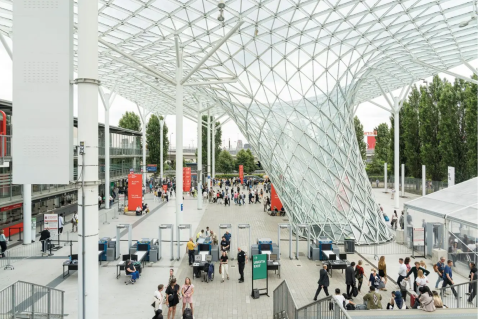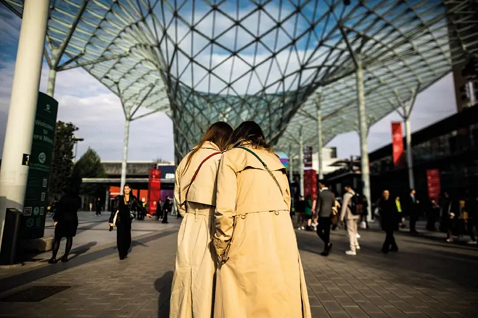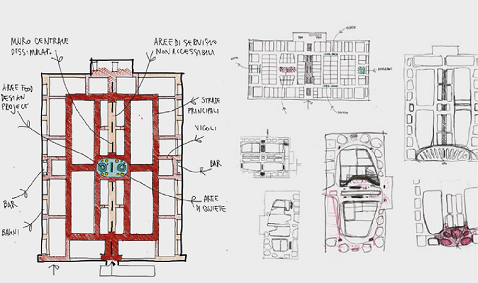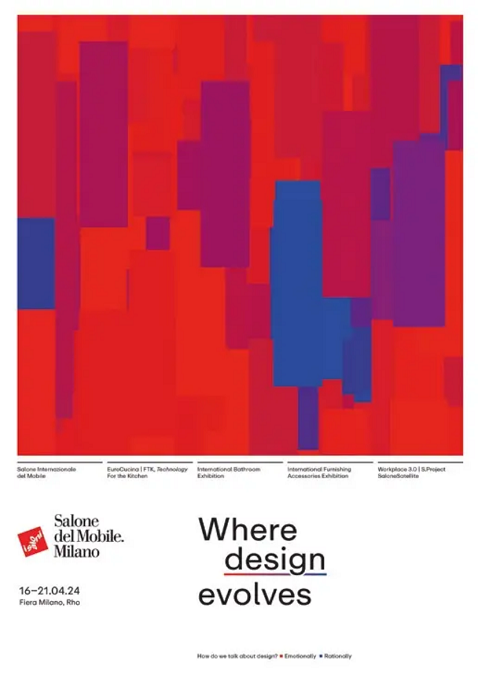
Visitors at the upcoming EuroCucina and International Bathroom Exhibition “Biennali” are in for a thrilling experience, as new exhibition paths have been designed following a human-centric philosophy, with the help of neuroscience and AI.
Three large immersive installations, pervasive cultural events, talks and tasting experiences linked to the food&design world: this and much more is awaiting visitors from all over the world at the 62nd edition of this leading design event slated for April 16th to 21st in Milan. DM talked to Salone del Mobile’s President Maria Porro.
.png)
At operational level this translates, among other novelties, into a radical rethink of layouts and itineraries within EuroCucina, with a communication campaign created through artificial intelligence. This year the FTK - Technology For the Kitchen - pavilion is integrated into the main venue, and the Salone Internazionale del Bagno was conceived with the contribution of neuroscience and under the banner of a human-at-the-center philosophy.
Also, visitors are offered an impressive, extensive cultural program throughout the event, not to mention the celebrations for the 25th anniversary of the SaloneSatellite, a launchpad for young designers and a reference point for companies seeking new talents. This edition boasts around 600 designers from 37 countries and 22 Design Schools and International Universities from 13 countries. DM discussed all of this, and more, with President Maria Porro:
In the 2024 edition of the Salone del Mobile, FTK-Technology For the Kitchen is effectively integrated into the new spaces of EuroCucina. Is this confirmation that the world of appliances is playing an increasingly central role within the kitchen environment, also in terms of design?
It is absolutely so, the integration of appliances into kitchen design is a fact. Just think of fully integrated induction hobs in kitchens, or the invisible ones hidden under the surface of the countertop. The integration of FTK within EuroCucina is the result of the evolution of the furniture industry, which today, when called upon to design a new kitchen, starts from the technological innovations developed in the world of appliances. This integration also brings a greater design freedom and the use of new materials that allow for the creation of a seamless connection between the furniture and the appliances..png)
The new layouts of the Biennials also mean a new positioning in pavilions 2 and 4. What’s the reason behind this move?
In fact there are two: on one hand, to consolidate the physical location of the Biennials, which in the future will tend to stay there, and on the other hand, to create a whole district dedicated to the world of furniture, with all the major manufacturers who always participate in the event, and the various pavilions being closer to each other and more accessible.Also in this edition, many events will be related to food design…
Food design stands at the forefront of research in the culinary field. We chose to link many events to this theme, through the participation of independent culinary magazines, artists, and food designers, in order for food research to take center stage. This is also a way to evolve the “furniture” product, which aim is indeed to prepare and cook food. This “reverse” approach to the product represents, in my opinion, the most unrestricted and interesting form of research, both for visitors and for the companies participating in the Salone del Mobile.In the past months the Salone has been engaged in a world tour. For what purpose?
Our priority is to enhance the quality of visitors who come to the Salone, which is why we have chosen to promote it with a world tour, touching Europe, the United States, Canada, China, India, Japan, Korea, and South Africa. We were able to meet with high-quality stakeholders whom we want to come and visit the Salone and discover our companies and brands.

CREDITS: LOST AND ROLL. GIANLUCA VASSALLO
Shanghai’s Red Night last November proved the strategic importance of the Chinese market for Italian design. What opportunities does China offer today, and in the near future, for the world of Italian designer furniture?
The Salone has a crucial role in facilitating encounters among top players, which may translate into solid and enduring relationships over time. On one hand, it supports companies in strengthening existing connections, while on the other hand, it assists companies that have not yet entered foreign markets in discovering their optimal positioning. Moreover, when expanding abroad, the Salone handpicks the brands it introduces, thereby guaranteeing the quality expressed by these companies participating in the international editions. This role for the Salone del Mobile Shanghai is significant as it helps Chinese final consumers and buyers understand which players are the most important, innovative, and reliable. China is a vast territory, and currently, the distribution of brands is mostly limited to first-tier cities and only occasionally to second-tier ones. Therefore, it is a market that offers numerous opportunities, and the quality of designers is constantly improving. Consequently, establishing relationships with interior designers and architects would make for very interesting synergies for the world of Italian furniture. The COVID-19 pandemic put this opportunity on hold for a long time, but today, all conditions are there for it to happen.What contribution can the Salone del Mobile, and more broadly, Italian-made, offer to the Chinese/Asian markets in terms of environmental sustainability?
When I think of European Union’s regulations on environmental sustainability, the European Green Deal, or the United Nations Global Compact (advocated in 1999 to promote a sustainable global economy), there’s a very clear indication that the entire Italian furniture system and the Salone, both as the organiser of the event and in the content it offers, have moved along the sustainability path with great seriousness. This clearly shows in the ISO 20121 certification, obtained in 2023, for the sustainable management of the entire event and in particular of the areas dedicated to this subject, as well as for a series of initiatives and actions aimed at implementing principles of circularity and regeneration. These issues are central to our actions and to our thinking.In your opinion, what are the main challenges that designers and architects will have to face in designing the future of our homes and living spaces?
Certainly, the durability of products and their ability to be replaceable, repairable, and renewable will be increasingly appreciated. In practice, it’s about the intrinsic value of a product and its longevity. The test, therefore, lies not in the product itself but in the service offered to meet these requirements. This is a challenge of the greatest significance since it represents our most sustainable response at this time.
The Red Night
.png)
CREDITS: PHOTO LUCAS YOUNG, WEIJANG XU © SALONE DEL MOBILE.MILANO SHANGHAI
After an absence of three years, the Salone del Mobile made its return to Shanghai on November 7th with the exclusive event “The Red Night,” where it unveiled previews of the 62nd edition of the trade show and outlined future projects for the Salone del Mobile.Milano Shanghai.
EUROCUCINA’S NEW LAYOUT

CREDITS: LOMBARDINI22
Starting from the centrality of the individual and leveraging artificial intelligence, Studio Lombardini 22, a leading group on the Italian architecture and engineering scene, has redesigned the layout and paths within EuroCucina, FTK - Technology For the Kitchen - and the International Bathroom Exhibition. The pavilions’ locations have been totally redistributed, with exhibitors grouped by content and target visitors in order to enhance the visiting experience. For the first time, the two biennials are now located in pavilions 2 and 4, adjacent and interconnected. The exhibition spaces of EuroCucina and FTK have been integrated, abandoning the traditional grid display with the central “decumanus”, in favour of a ring-shaped track layout with a “boulevard”. A symmetrical path has been created by placing the booths against the external perimeter walls, as if they were shop windows in a city high street. By doing so, visitors can access all the booths by traveling half the distance compared to the traditional setup, without the risk of getting lost or confused. The main alleyways, at least 6 meters wide, have been clearly differentiated from the secondary ones, making orientation simpler, and cultural installations and quiet areas have been inserted in the wider boulevards.
“INTERIORS BY DAVID LYNCH. A THINKING ROOM”

.png)
A communication campaign using generative AI
It’s called “Where Design Evolves” and it’s the new communication campaign of the Salone del Mobile.Milano 2024. It was conceived by Publicis Groupe with the scientific collaboration of Paolo Ciuccarelli, a design professor and founder of the DensityDesign Lab at the Politecnico di Milano and the Center for Design at Northeastern University in Boston.

The key visuals were created using generative Artificial Intelligence to understand, analyse, and visualise the stories, relationships, and emotions that the event brings out throughout the year. The new all-channel communication platform, using AI-driven processes, was specially developed to analyse conversations on relevant topics, catch real-time debates in the community, hear the voice of brands, designers, and visitors, expressing their thoughts, through a constantly evolving fluid platform.
By integrating human creativity with the innovative power of Artificial Intelligence, the various key visuals of the campaign will become true harbingers of experiences, memories, and conversations, constantly evolving and conveying the emotions stirred by the event in real-time.
Copyright © Homa 2025
All rights reserved

.jpg?VGhlIFBlcmZlY3QgU2xvdC1pbijmraPnoa4pLmpwZw==)

































